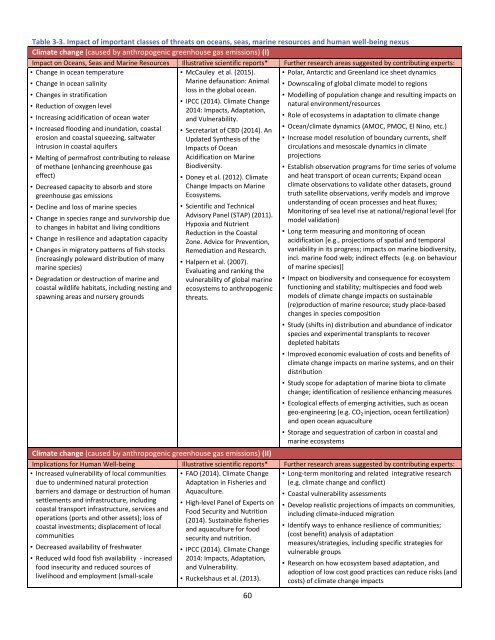1HlG51J
1HlG51J
1HlG51J
You also want an ePaper? Increase the reach of your titles
YUMPU automatically turns print PDFs into web optimized ePapers that Google loves.
Table 3-3. Impact of important classes of threats on oceans, seas, marine resources and human well-being nexusClimate change (caused by anthropogenic greenhouse gas emissions) (I)Impact on Oceans, Seas and Marine Resources Illustrative scientific reports* Further research areas suggested by contributing experts:• Change in ocean temperature• Change in ocean salinity• Changes in stratification• Reduction of oxygen level• Increasing acidification of ocean water• Increased flooding and inundation, coastalerosion and coastal squeezing, saltwaterintrusion in coastal aquifers• Melting of permafrost contributing to releaseof methane (enhancing greenhouse gaseffect)• Decreased capacity to absorb and storegreenhouse gas emissions• Decline and loss of marine species• Change in species range and survivorship dueto changes in habitat and living conditions• Change in resilience and adaptation capacity• Changes in migratory patterns of fish stocks(increasingly poleward distribution of manymarine species)• Degradation or destruction of marine andcoastal wildlife habitats, including nesting andspawning areas and nursery grounds• McCauley et al. (2015).Marine defaunation: Animalloss in the global ocean.• IPCC (2014). Climate Change2014: Impacts, Adaptation,and Vulnerability.• Secretariat of CBD (2014). AnUpdated Synthesis of theImpacts of OceanAcidification on MarineBiodiversity.• Doney et al. (2012). ClimateChange Impacts on MarineEcosystems.• Scientific and TechnicalAdvisory Panel (STAP) (2011).Hypoxia and NutrientReduction in the CoastalZone. Advice for Prevention,Remediation and Research.• Halpern et al. (2007).Evaluating and ranking thevulnerability of global marineecosystems to anthropogenicthreats.60• Polar, Antarctic and Greenland ice sheet dynamics• Downscaling of global climate model to regions• Modelling of population change and resulting impacts onnatural environment/resources• Role of ecosystems in adaptation to climate change• Ocean/climate dynamics (AMOC, PMOC, El Nino, etc.)• Increase model resolution of boundary currents, shelfcirculations and mesoscale dynamics in climateprojections• Establish observation programs for time series of volumeand heat transport of ocean currents; Expand oceanclimate observations to validate other datasets, groundtruth satellite observations, verify models and improveunderstanding of ocean processes and heat fluxes;Monitoring of sea level rise at national/regional level (formodel validation)• Long term measuring and monitoring of oceanacidification [e.g., projections of spatial and temporalvariability in its progress; impacts on marine biodiversity,incl. marine food web; indirect effects (e.g. on behaviourof marine species)]• Impact on biodiversity and consequence for ecosystemfunctioning and stability; multispecies and food webmodels of climate change impacts on sustainable(re)production of marine resource; study place-basedchanges in species composition• Study (shifts in) distribution and abundance of indicatorspecies and experimental transplants to recoverdepleted habitats• Improved economic evaluation of costs and benefits ofclimate change impacts on marine systems, and on theirdistribution• Study scope for adaptation of marine biota to climatechange; identification of resilience enhancing measures• Ecological effects of emerging activities, such as oceangeo-engineering (e.g. CO 2 injection, ocean fertilization)and open ocean aquaculture• Storage and sequestration of carbon in coastal andmarine ecosystemsClimate change (caused by anthropogenic greenhouse gas emissions) (II)Implications for Human Well-being Illustrative scientific reports* Further research areas suggested by contributing experts:• Increased vulnerability of local communitiesdue to undermined natural protection• FAO (2014). Climate ChangeAdaptation in Fisheries and• Long-term monitoring and related integrative research(e.g. climate change and conflict)barriers and damage or destruction of human Aquaculture.• Coastal vulnerability assessmentssettlements and infrastructure, including • High-level Panel of Experts on • Develop realistic projections of impacts on communities,coastal transport infrastructure, services and Food Security and Nutrition including climate-induced migrationoperations (ports and other assets); loss of (2014). Sustainable fisheriescoastal investments; displacement of local and aquaculture for foodcommunitiessecurity and nutrition.• Decreased availability of freshwater• Reduced wild food fish availability - increasedfood insecurity and reduced sources oflivelihood and employment (small-scale• IPCC (2014). Climate Change2014: Impacts, Adaptation,and Vulnerability.• Ruckelshaus et al. (2013).• Identify ways to enhance resilience of communities;(cost benefit) analysis of adaptationmeasures/strategies, including specific strategies forvulnerable groups• Research on how ecosystem based adaptation, andadoption of low cost good practices can reduce risks (andcosts) of climate change impacts




